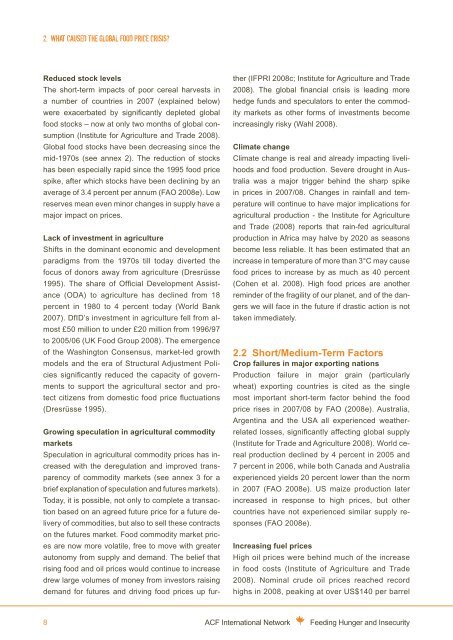Feeding hunger and insecurity
Feeding hunger and insecurity
Feeding hunger and insecurity
- No tags were found...
You also want an ePaper? Increase the reach of your titles
YUMPU automatically turns print PDFs into web optimized ePapers that Google loves.
2. what caused the global food price crisis?Reduced stock levelsThe short-term impacts of poor cereal harvests ina number of countries in 2007 (explained below)were exacerbated by significantly depleted globalfood stocks – now at only two months of global consumption(Institute for Agriculture <strong>and</strong> Trade 2008).Global food stocks have been decreasing since themid-1970s (see annex 2). The reduction of stockshas been especially rapid since the 1995 food pricespike, after which stocks have been declining by anaverage of 3.4 percent per annum (FAO 2008e). Lowreserves mean even minor changes in supply have amajor impact on prices.Lack of investment in agricultureShifts in the dominant economic <strong>and</strong> developmentparadigms from the 1970s till today diverted thefocus of donors away from agriculture (Dresrüsse1995). The share of Official Development Assistance(ODA) to agriculture has declined from 18percent in 1980 to 4 percent today (World Bank2007). DfID’s investment in agriculture fell from almost£50 million to under £20 million from 1996/97to 2005/06 (UK Food Group 2008). The emergenceof the Washington Consensus, market-led growthmodels <strong>and</strong> the era of Structural Adjustment Policiessignificantly reduced the capacity of governmentsto support the agricultural sector <strong>and</strong> protectcitizens from domestic food price fluctuations(Dresrüsse 1995).Growing speculation in agricultural commoditymarketsSpeculation in agricultural commodity prices has increasedwith the deregulation <strong>and</strong> improved transparencyof commodity markets (see annex 3 for abrief explanation of speculation <strong>and</strong> futures markets).Today, it is possible, not only to complete a transactionbased on an agreed future price for a future deliveryof commodities, but also to sell these contractson the futures market. Food commodity market pricesare now more volatile, free to move with greaterautonomy from supply <strong>and</strong> dem<strong>and</strong>. The belief thatrising food <strong>and</strong> oil prices would continue to increasedrew large volumes of money from investors raisingdem<strong>and</strong> for futures <strong>and</strong> driving food prices up further(IFPRI 2008c; Institute for Agriculture <strong>and</strong> Trade2008). The global financial crisis is leading morehedge funds <strong>and</strong> speculators to enter the commoditymarkets as other forms of investments becomeincreasingly risky (Wahl 2008).Climate changeClimate change is real <strong>and</strong> already impacting livelihoods<strong>and</strong> food production. Severe drought in Australiawas a major trigger behind the sharp spikein prices in 2007/08. Changes in rainfall <strong>and</strong> temperaturewill continue to have major implications foragricultural production - the Institute for Agriculture<strong>and</strong> Trade (2008) reports that rain-fed agriculturalproduction in Africa may halve by 2020 as seasonsbecome less reliable. It has been estimated that anincrease in temperature of more than 3°C may causefood prices to increase by as much as 40 percent(Cohen et al. 2008). High food prices are anotherreminder of the fragility of our planet, <strong>and</strong> of the dangerswe will face in the future if drastic action is nottaken immediately.2.2 Short/Medium-Term FactorsCrop failures in major exporting nationsProduction failure in major grain (particularlywheat) exporting countries is cited as the singlemost important short-term factor behind the foodprice rises in 2007/08 by FAO (2008e). Australia,Argentina <strong>and</strong> the USA all experienced weatherrelatedlosses, significantly affecting global supply(Institute for Trade <strong>and</strong> Agriculture 2008). World cerealproduction declined by 4 percent in 2005 <strong>and</strong>7 percent in 2006, while both Canada <strong>and</strong> Australiaexperienced yields 20 percent lower than the normin 2007 (FAO 2008e). US maize production laterincreased in response to high prices, but othercountries have not experienced similar supply responses(FAO 2008e).Increasing fuel pricesHigh oil prices were behind much of the increasein food costs (Institute of Agriculture <strong>and</strong> Trade2008). Nominal crude oil prices reached recordhighs in 2008, peaking at over US$140 per barrel8ACF International Network<strong>Feeding</strong> Hunger <strong>and</strong> Insecurity

















